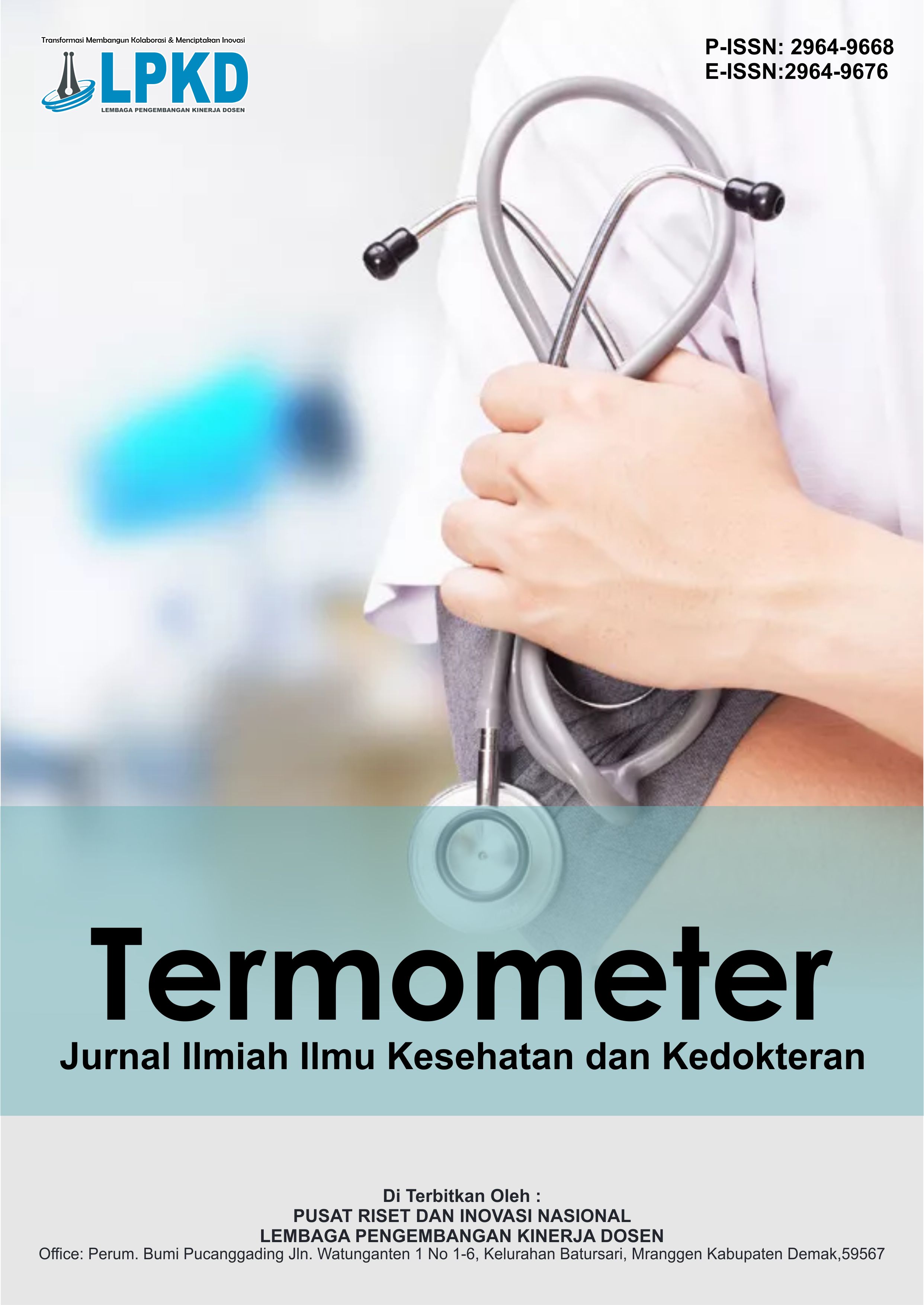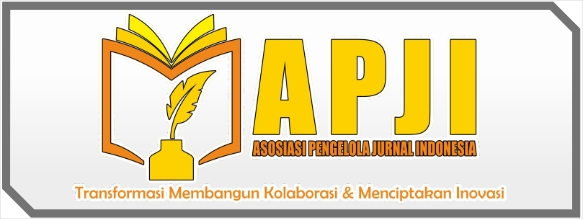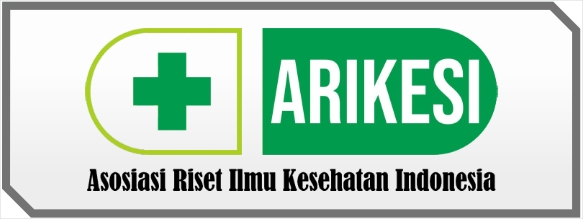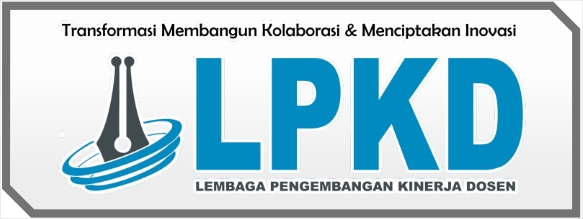Hubungan Antara Indeks Massa Tubuh dan Riwayat Keluarga dengan Kejadian Anomali Refraksi pada Siswa Kelas 5 dan 6 SD Muhammadiyah Kleco
DOI:
https://doi.org/10.55606/termometer.v3i1.4788Keywords:
Body Mass Index, Family History, Refractive AnomaliesAbstract
Refractive anomalies in children are still an important vision problem to be treated. Refractive anomalies that are not handled properly at an age of children are prone to developing advanced vision problems such as lazy eye (amblyopia). Prevention needs to be carried out so that the occurrence of refractive anomalies in children can be minimized, one of which is by knowing the risk factors that trigger this refractive anomaly. This study aims to find a relationship between body mass index and family history of refractive anomalies and the incidence of refractive anomalies in children. The research was conducted on 5th and 6th grade students at SD Muhammadiyah Kleco, Yogyakarta. A total of 42 students with refractive errors were obtained, which was then analyzed regarding the relationship between body mass index and family history and the occurrence of refractive anomalies they experienced. A statistically significant relationship was obtained between family history and the incidence of refractive anomalies (p=0.009). There was no statistically significant relationship between body mass index and the incidence of refractive anomalies (p=0.321).
Downloads
References
Anindira, A. (2017). Hubungan gangguan tidur dengan terjadinya miopia pada anak. http://repository.umy.ac.id/handle/123456789/11209
Budi, D. R., Listiandi, A. D., Festiawan, R., Widanita, N., & Anggraeni, D. (2020). Indeks masa tubuh (IMT): Kajian analisis pada atlet renang junior usia sekolah dasar. TEGAR: Journal of Teaching Physical Education in Elementary School, 3(2), 46–53. https://doi.org/10.17509/tegar.v3i2.24452
Budiono, S. (2019). Buku ajar ilmu kesehatan mata. Airlangga University Press.
Czepita, M., Czepita, D., & Safranow, K. (2019). Role of gender in the prevalence of myopia among Polish schoolchildren. Journal of Ophthalmology, 2019, 1–4. https://doi.org/10.1155/2019/9748576
Du, W., Ding, G., Guo, X., Abudukeyimu, K., Wang, Y., Wang, L., Qi, X., Ning, Y., Hua, N., Song, L., Li, X., Li, J., Zhang, Y., Wei, N., & Qian, X. (2023). Associations between anthropometric indicators and refraction in school-age children during the post-COVID-19 era. Frontiers in Public Health, 10, 1059465. https://doi.org/10.3389/fpubh.2022.1059465
Enira, T. (2016). Prevalensi dan penyebab kelainan refraksi pada anak usia sekolah di Sekolah Dasar Muhammadiyah 16 Palembang. Fakultas Kedokteran Universitas Muhammadiyah Palembang.
Fauzi, L., Anggorowati, L., & Heriana, C. (2016). Skrining kelainan refraksi mata pada siswa sekolah dasar menurut tanda dan gejala. Unnes Journal of Public Health, 7.
Fu, T., Xiang, Y., & Wang, J.-M. (2023). Progression of myopia among undergraduate students in central China. International Journal of Ophthalmology, 16(2), 274–279. https://doi.org/10.18240/ijo.2023.02.15
Galvis, V., Tello, A., Camacho, P. A., Gómez, L. M., Rey, J. J., & Serrano, A. A. (2021). Definition of refractive errors for research studies: Spherical equivalent could not be enough. Journal of Optometry, 14(2), 224–225. https://doi.org/10.1016/j.optom.2020.10.003
Habut, M. Y., Nurmawan, I. P. S., & Wiryanthini, I. A. D. (2016). Hubungan indeks massa tubuh dan aktivitas fisik terhadap keseimbangan dinamis pada mahasiswa Fakultas Kedokteran Universitas Udayana. Majalah Ilmiah Fisioterapi Indonesia, 4(2). https://doi.org/10.24843/MIFI.2016.v04.i02.p08
Hall, J. E. (2016). Guyton and Hall textbook of medical physiology (13th ed.). Elsevier.
Harrington, S., & O’Dwyer, V. (2023). The association between time spent on screens and reading with myopia, premyopia, and ocular biometric, and anthropometric measures in 6‐ to 7‐year‐old schoolchildren in Ireland. Ophthalmic and Physiological Optics, 43(3), 505–516. https://doi.org/10.1111/opo.13116
Ilman, D. A. (2017). Perbedaan antara hasil pemeriksaan oftalmoskop direk dengan pemeriksaan subyektif trial lens pada pasien dengan anomali refraksi [Thesis, Universitas Islam Indonesia]. https://dspace.uii.ac.id/handle/123456789/29120
Jiang, D., Lin, H., Li, C., Liu, L., Xiao, H., Lin, Y., Huang, X., & Chen, Y. (2021). Longitudinal association between myopia and parental myopia and outdoor time among students in Wenzhou: A 2.5-year longitudinal cohort study. BMC Ophthalmology, 21(1), 11. https://doi.org/10.1186/s12886-020-01763-9
Jones-Jordan, L. A., Sinnott, L. T., Chu, R. H., Cotter, S. A., Kleinstein, R. N., Manny, R. E., Mutti, D. O., Twelker, J. D., Zadnik, K., & for the CLEERE Study Group. (2021). Myopia progression as a function of sex, age, and ethnicity. Investigative Opthalmology & Visual Science, 62(10), 36. https://doi.org/10.1167/iovs.62.10.36
Jones-Jordan, L. A., Sinnott, L. T., Manny, R. E., Cotter, S. A., Kleinstein, R. N., Mutti, D. O., Twelker, J. D., & Zadnik, K. (2010). Early childhood refractive error and parental history of myopia as predictors of myopia. Investigative Opthalmology & Visual Science, 51(1), 115. https://doi.org/10.1167/iovs.08-3210
Kearney, S., Strang, N. C., Cagnolati, B., & Gray, L. S. (2020). Change in body height, axial length, and refractive status over a four-year period in Caucasian children and young adults. Journal of Optometry, 13(2), 128–136. https://doi.org/10.1016/j.optom.2019.12.008
Kim, H., Seo, J. S., Yoo, W.-S., Kim, G.-N., Kim, R. B., Chae, J. E., Chung, I., Seo, S.-W., & Kim, S. J. (2020). Factors associated with myopia in Korean children: Korea National Health and Nutrition Examination Survey 2016-2017 (KNHANES VII). BMC Ophthalmology, 20(1), 31. https://doi.org/10.1186/s12886-020-1316-6
Komariah, C., & Wahyu A, N. (2014). Hubungan status refraksi dengan kebiasaan membaca, aktivitas di depan komputer, dan status refraksi orang tua pada anak usia sekolah dasar. Jurnal Kedokteran Brawijaya, 28(2), 137–140. https://doi.org/10.21776/ub.jkb.2014.028.02.14
Lee, D. C., Lee, S. Y., & Kim, Y. C. (2018). An epidemiological study of the risk factors associated with myopia in young adult men in Korea. Scientific Reports, 8(1), 511. https://doi.org/10.1038/s41598-017-18926-2
Lee, S., Lee, H.-J., Lee, K. G., & Kim, J. (2022). Obesity and high myopia in children and adolescents: Korea National Health and Nutrition Examination Survey. PLOS ONE, 17(3), e0265317. https://doi.org/10.1371/journal.pone.0265317
Lestari, K. D., Handayani, T. A., Pemayun, C. I. D., & Manuaba, I. B. P. (2019). Karakteristik dan perbedaan kelainan refraksi pada anak usia sekolah dasar di Sekolah Dasar Cipta Dharma Denpasar Februari 2014. Medicina, 50(2). https://doi.org/10.15562/medicina.v50i2.224
Lestari, T., Anggunan, A., Triwahyuni, T., & Syuhada, R. (2020). Studi faktor risiko kelainan miopia di Rumah Sakit Pertamina Bintang Amin. Jurnal Ilmiah Kesehatan Sandi Husada, 11(1), 305–312. https://doi.org/10.35816/jiskh.v11i1.275
Lim, D. H., Han, J., Chung, T.-Y., Kang, S., Yim, H. W., & on behalf of The Epidemiologic Survey Committee of the Korean Ophthalmologic Society. (2018). The high prevalence of myopia in Korean children with influence of parental refractive errors: The 2008-2012 Korean National Health and Nutrition Examination Survey. PLOS ONE, 13(11), e0207690. https://doi.org/10.1371/journal.pone.0207690
Liwang, F., Wijaya, E., Yuswar, P. W., & Sanjaya, N. P. (2020). Kapita selekta kedokteran: Jilid II (Edisi V). Media Aesculapius.
Mahfud, I., Gumantan, A., & Fahrizqi, E. B. (2020). Analisis IMT (Indeks Massa Tubuh) atlet UKM sepakbola Universitas Teknokrat Indonesia. 3, 5.
Mamesah, I., Saerang, J. S. M., & Rares, L. M. (2016). Kelainan refraksi pada siswa SMP daerah pedesaan. e-CliniC, 4(2). https://doi.org/10.35790/ecl.4.2.2016.12659
Mejecase, C., Malka, S., Guan, Z., Slater, A., Arno, G., & Moosajee, M. (2020). Practical guide to genetic screening for inherited eye diseases. Therapeutic Advances in Ophthalmology, 12, 251584142095459. https://doi.org/10.1177/2515841420954592
Miswanuddin, 3231113012. (2015, Desember 18). Menangis dalam perspektif hadis (Telaah Ma’ani al-Hadis) [Skripsi]. IAIN Tulungagung. http://repo.uinsatu.ac.id/3071/
Mohd-Ali, B., Low, Y. C., Shahimin, M. M., Arif, N., Abdul Hamid, H., Wan Abdul Halim, W. H., Mokri, S. S., Baseri Huddin, A., & Mohidin, N. (2022). Ocular dimensions, refractive error, and body stature in young Chinese children with myopia in Kuala Lumpur, Malaysia. Clinical Optometry, 14, 101–110. https://doi.org/10.2147/OPTO.S368672
Muttaqin, R. F. (2018). Hubungan indeks massa tubuh (IMT) terhadap kejadian miopia pada pelajar SMPN 7 Kota Jambi tahun 2018. 11.
Nisak, S. K. (2018). Kelelahan mata berdasarkan intensitas pencahayaan, jenis pekerjaan, dan kelainan refraksi mata (Studi pada pekerja konveksi X di Kota Semarang) [Undergraduate, Universitas Muhammadiyah Semarang]. http://repository.unimus.ac.id/2561/
Nurullah, N. (2013). Hubungan antara jenis kelamin, faktor genetik, dan aktivitas melihat jarak dekat dengan kejadian miopia pada pelajar SMK St. Patrick di Sabah, Malaysia. 66.
Prahantyo, R. I. (2017). Hubungan miopia terhadap prestasi belajar pada anak usia sekolah dasar. http://repository.umy.ac.id/handle/123456789/11955
Prayoga, H. A. (2014). Intensitas pencahayaan dan kelainan refraksi mata terhadap kelelahan mata. 6.
Ramadona, E. T., & Hastuti, T. A. (2018). Hubungan indeks massa tubuh dan tingkat aktivitas fisik pada siswa sekolah dasar kelas V di SD Negeri Samirono Kecamatan Depok Kabupaten Sleman. PGSD Penjaskes, 7(3), Article 3. https://journal.student.uny.ac.id/index.php/pgsd-penjaskes/article/view/10848
Rathi, M., Chhabra, S., Sachdeva, S., Rustagi, I., Soni, D., & Dhania, S. (2022). Correlation of parental and childhood myopia in children aged 5-16 years in North India. Indian Journal of Ophthalmology, 70(9), 3366. https://doi.org/10.4103/ijo.IJO_653_22
Saiyang, B., Rares, L. M., & Supit, W. P. (2021). Kelainan refraksi mata pada anak. Medical Scope Journal, 2(2). https://doi.org/10.35790/msj.2.2.2021.32115
Tang, S. M., Kam, K. W., French, A. N., Yu, M., Chen, L. J., Young, A. L., Rose, K. A., Tham, C. C., Pang, C. P., & Yam, J. C. (2020). Independent influence of parental myopia on childhood myopia in a dose-related manner in 2,055 trios: The Hong Kong Children Eye Study. American Journal of Ophthalmology, 218, 199–207. https://doi.org/10.1016/j.ajo.2020.05.026
Terasaki, H., Yamashita, T., Yoshihara, N., Kii, Y., & Sakamoto, T. (2017). Association of lifestyle and body structure to ocular axial length in Japanese elementary school children. BMC Ophthalmology, 17(1), 123. https://doi.org/10.1186/s12886-017-0519-y
Theophanous, C., Modjtahedi, B., Batech, M., Marlin, D., Luong, T., & Fong, D. (2018). Myopia prevalence and risk factors in children. Clinical Ophthalmology, 12, 1581–1587. https://doi.org/10.2147/OPTH.S164641
Wulansari, D., Rahmi, F. L., & Nugroho, T. (2018). Faktor-faktor yang berhubungan dengan miopia pada anak SD di daerah perkotaan dan daerah pinggiran. 7(2), 15.
Yamashita, T., Iwase, A., Sakai, H., Terasaki, H., Sakamoto, T., & Araie, M. (2019). Differences of body height, axial length, and refractive error at different ages in Kumejima study. Graefe’s Archive for Clinical and Experimental Ophthalmology, 257(2), 371–378. https://doi.org/10.1007/s00417-018-4192-5
Downloads
Published
How to Cite
Issue
Section
License
Copyright (c) 2025 Termometer: Jurnal Ilmiah Ilmu Kesehatan dan Kedokteran

This work is licensed under a Creative Commons Attribution-ShareAlike 4.0 International License.










